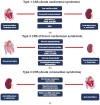Heart Failure and Cardiorenal Syndrome: A Narrative Review on Pathophysiology, Diagnostic and Therapeutic Regimens-From a Cardiologist's View
- PMID: 36498617
- PMCID: PMC9741317
- DOI: 10.3390/jcm11237041
Heart Failure and Cardiorenal Syndrome: A Narrative Review on Pathophysiology, Diagnostic and Therapeutic Regimens-From a Cardiologist's View
Abstract
In cardiorenal syndrome (CRS), heart failure and renal failure are pathophysiologically closely intertwined by the reciprocal relationship between cardiac and renal injury. Type 1 CRS is most common and associated with acute heart failure. A preexistent chronic kidney disease (CKD) is common and contributes to acute kidney injury (AKI) in CRS type 1 patients (acute cardiorenal syndrome). The remaining CRS types are found in patients with chronic heart failure (type 2), acute and chronic kidney diseases (types 3 and 4), and systemic diseases that affect both the heart and the kidney (type 5). Establishing the diagnosis of CRS requires various tools based on the type of CRS, including non-invasive imaging modalities such as TTE, CT, and MRI, adjuvant volume measurement techniques, invasive hemodynamic monitoring, and biomarkers. Albuminuria and Cystatin C (CysC) are biomarkers of glomerular filtration and integrity in CRS and have a prognostic impact. Comprehensive "all-in-one" magnetic resonance imaging (MRI) approaches, including cardiac magnetic resonance imaging (CMR) combined with functional MRI of the kidneys and with brain MRI are proposed for CRS. Hospitalizations due to CRS and mortality are high. Timely diagnosis and initiation of effective adequate therapy, as well as multidisciplinary care, are pertinent for the improvement of quality of life and survival. In addition to the standard pharmacological heart failure medication, including SGLT2 inhibitors (SGLT2i), renal aspects must be strongly considered in the context of CRS, including control of the volume overload (diuretics) with special caution on diuretic resistance. Devices involved in the improvement of myocardial function (e.g., cardiac resynchronization treatment in left bundle branch block, mechanical circulatory support in advanced heart failure) have also shown beneficial effects on renal function.
Keywords: cardiorenal syndrome; heart failure; pathophysiology; prognosis; treatment.
Conflict of interest statement
M.N. has received honoraria for presentations and/or participated in advisory boards from Abbott, Abiomed, AstraZeneca, Bayer, Boehringer Ingelheim, Bristol-Myers Squibb, Novartis, and Pfizer. All remaining authors declare no conflict of interest.
Figures
References
-
- Liangos O., Perianayagam M.C., Vaidya V.S., Han W.K., Wald R., Tighiouart H., MacKinnon R.W., Li L., Balakrishnan V.S., Pereira B.J., et al. Urinary N-acetyl-beta-(D)-glucosaminidase activity and kidney injury molecule-1 level are associated with adverse outcomes in acute renal failure. J. Am. Soc. Nephrol. 2007;18:904–912. doi: 10.1681/ASN.2006030221. - DOI - PubMed
-
- Mishra J., Dent C., Tarabishi R., Mitsnefes M.M., Ma Q., Kelly C., Ruff S.M., Zahedi K., Shao M., Bean J., et al. Neutrophil gelatinase-associated lipocalin (NGAL) as a biomarker for acute renal injury after cardiac surgery. Lancet. 2005;365:1231–1238. doi: 10.1016/S0140-6736(05)74811-X. - DOI - PubMed
Publication types
LinkOut - more resources
Full Text Sources




